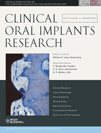The influence of perforating the autogenous block bone and the recipient bed in dogs. Part I: a radiographic analysis
Abstract
Objectives: This study evaluated radiographically the integration and volume maintenance of grafted autogenous block bone under various cortical bone perforation conditions in dogs.
Material and methods: Five mongrel dogs were used. Each dog received four differently prepared onlay block bone grafts: a solid block graft was fixed on either (1) a cortically perforated recipient bed (SGPR) or (2) a nonperforated recipient bed (SGNPR), a perforated block graft was fixed on either (3) a nonperforated recipient bed (PGNPR) or (4) a cortically perforated recipient bed (PGPR). The animals were sacrificed at 1 day, 4 days, 10 days, 4 weeks, and 8 weeks after surgery. Specimens were prepared and radiographic analysis was conducted by using micro-computed tomography. The residual bone volume (RBV; mm3), cross-sectional bone area (BA; mm2), and residual height (RH; %) of the grafted block bone were measured radiographically.
Results: The interface between the recipient bed and the graft showed no signs of bone integration at 1, 4, and 10 days of healing. However, at 4 weeks of healing, bone integration was observed in all groups. The RBV, BA, and RH of the grafts gradually decreased by 4 weeks of healing. At 8 weeks, the PGPR condition exhibited a higher RBV, BA, and RH than the other conditions, whereas the SGNPR condition exhibited the lowest RBV, BA, and RH.
Conclusion: Within the limitations of this study, it can be concluded that intentional cortical perforation on the recipient bed and block bone graft may influence volume maintenance of the graft.
To cite this article: Oh K-C, Cha J-K, Kim C-S, Choi S-H, Chai J-K, Jung U-W. The influence of perforating the autogenous block bone and the recipient bed in dogs. Part I: a radiographic analysis.Clin. Oral Impl. Res. 22, 2011; 1298–1302.doi: 10.1111/j.1600-0501.2010.02110.x




